| Back Number | No.10 2005/03/02 | |||
| Special Feature | How to Get to the EXPO 2005 Venue |  |
||
| Pavilions : JAMA Wonder Wheel Pavilion | ||||
| Interview | Pablo Bravo (Spain) Spanish Commissioner General of EXPO 2005 Aichi, Japan |
|||
![]()
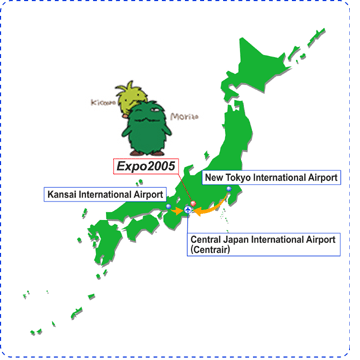 From the World to Japan
From the World to JapanThere are currently 24 airports in Japan with regularly scheduled international flights. In this issue, we will introduce how to get to the EXPO 2005 Aichi, Japan venue from three international airports: Central Japan International Airport (Centrair), New Tokyo International Airport (Narita Airport) and Kansai International Airport. Please note that transportation charges shown here are as of March 1, 2005. (For your information, the March 1, 2005 yen/dollar exchange rate on the Tokyo foreign exchange market was 105.52 yen/U.S. dollar.) The travel time shown is a total of the actual time that the mode of transport is in transit and does not include the time necessitated for making transfers, etc. We ask that you confirm important matters before making your journey. |
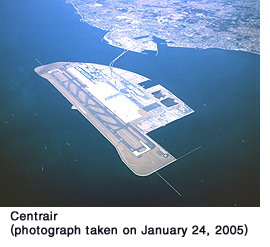 How to Go to the EXPO 2005 Venue from Centrair
How to Go to the EXPO 2005 Venue from CentrairCentral Japan International Airport (Centrair), which just opened on February 17 this year, is the third airport in Japan based in the vicinity a major city. It operates 24 hours a day. Centrair offers an enriched transportation network with 94 scheduled flights serving 24 cities in Japan per day, and 271 scheduled flights serving 25 cities around the world each week (as of February 17, 2005). It is convenient for making transfers to domestic and international flights. For details, please refer to the Centrair website: http://www.centrair.jp/en/index.html. |
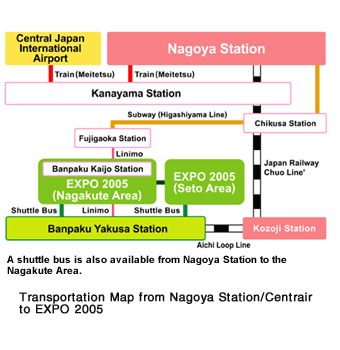 The fastest travel time from Centrair to the EXPO 2005 venue is about 1 hour. Here’s how to get to the Expo.
The fastest travel time from Centrair to the EXPO 2005 venue is about 1 hour. Here’s how to get to the Expo.From Centrair, take the Nagoya Railroad (Meitetsu) to Kanayama Station and transfer to the Japan Railway (JR) Chuo Line’s EXPO Shuttle operated during EXPO 2005 which will allow you to go directly to Banpaku Yakusa Station. (Total travel time, 58 minutes; total fee, 1,570 yen.) From Banpaku Yakusa Station, take the Linimo to Banpaku Kaijo Station at the Nagakute Area (3 minutes; 160 yen). If you want to go to the Seto Area, take the shuttle bus from Banpaku Yakusa Station (5 minutes; 160yen). Please note that there is a roundtrip discount ticket available between JR Kanayama Station and Linimo’s Banpaku Kaijo Station priced at 1,300 yen. |
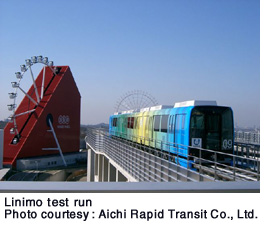 “Linimo” is a mag-lev linear motor car that travels at a maximum speed of 100km/h. It consists of three cars and has a capacity of carrying 244 people. This is the first commercial operation of a linear motor car in Japan.
“Linimo” is a mag-lev linear motor car that travels at a maximum speed of 100km/h. It consists of three cars and has a capacity of carrying 244 people. This is the first commercial operation of a linear motor car in Japan.Nagoya Railroad (Meitetsu) is a convenient way to go from Centrair to Nagoya Station, the base of rail transport in Aichi Prefecture (28 minutes; 850 yen). |
|
From Kansai International Airport to Nagoya Station From Kansai International Airport, travel by train to JR Shin-Osaka Station (about 50 minutes; 2,980 yen). From Shin-Osaka Station, travel by bullet train and get off at Nagoya Station (about 50 minutes; 6,380 yen). From New Tokyo International Airport (Narita Airport) to Nagoya Station From New Tokyo International Airport (Narita Airport), travel by air to Centrair (about 1 hour 20 minutes; 15,500 yen). An alternate method is to go to Tokyo Station from Narita Airport by JR’s Narita Express (about 1 hour; 2,940 yen), and then take the bullet to Nagoya Station (about 1 hour and 45 minutes; 10,780 yen). From Japan Railway (JR) Nagoya Station to the EXPO 2005 Venue It takes less than 1 hour to go from Nagoya Station to the EXPO 2005 venue. Major ways to go from Nagoya Station to the EXPO are as follows. <By Train> EXPO Shuttle, a train that goes directly from Nagoya Station to Banpaku Yakusa Station, will be operating during EXPO 2005 (fastest travel time, 38 minutes; 780 yen). From Banpaku Yakusa Station, take the Linimo to Banpaku Kaijo Station at the Nagakute Area. If you want to go to the Seto Area, take the shuttle bus from Banpaku Yakusa Station. Please note that you can purchase a discounted roundtrip ticket for traveling between various JR stations within Nagoya City to Linimo’s Banpaku Station priced at 1,300 yen. An alternate route is to take the Higashiyama Subway Line from Nagoya Station. Get off at Fujigaoka Station (25 minutes; 290 yen). From there, take the Linimo to Banpaku Kaijo Station at the Nagakute Area (12 minutes; 340 yen). Please note that congestion is anticipated for this route, so we recommend that you take the aforementioned route via Banpaku Yakusa Station. <By Shuttle Bus> Shuttle buses will be operating every day during EXPO 2005 from Nagoya Station to the Nagakute Area. The direct service bus will be leaving every 15 minutes (every 10 minutes during peak hours). The travel time is 35 minutes. The charge is 1,000 yen (discounted to 1,500 yen if you purchase a roundtrip ticket). Please note however, that the travel time by shuttle bus may differ according to traffic conditions. Going to EXPO 2005 by Car (Use of the Park & Ride Parking Lot) Park & Ride is a system established in order to alleviate traffic congestion as well as lighten the burden placed on the environment. Private automobiles and motorcycles will be parked at the Park & Ride Parking Lot, and passengers will travel from there to the EXPO 2005 venue by shuttle bus. There will be six such parking lots in the vicinity of the EXPO. Parking fees in the case of ordinary vehicles is 2,500 yen/day/vehicle at the Nagoya Airport Park & Ride parking lot and 3,000 yen/day/vehicle at other Park & Ride parking lots. There will be a free shuttle bus operating between the parking lots and the Expo venue. Welcome to EXPO 2005 The transportation routes introduced here are only some examples, and there are various other ways to get to EXPO 2005. If you would like detailed information, we suggest that you contact the EXPO 2005 Aichi, Japan Call Center. Japanese, English, Chinese and Korean are spoken at the call center (Phone number: +81-52-955-2005). For details please see http://www-1.expo2005.or.jp/en/contacts/callcenter.html/. March, the month in which EXPO 2005 will commence is finally here. EXPO 2005 Aichi, Japan welcomes the people of the world. |
![]()
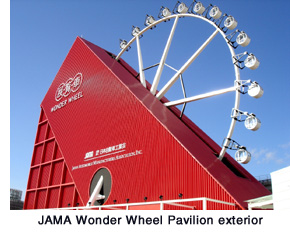 The message that will be conveyed by the JAMA Wonder Wheel Pavilion presented by the Japan Automobile Manufacturers Association, Inc. (JAMA), whose members consist of Japanese automakers, concerns the new challenges being addressed in order to create a rich future in which people, vehicles and nature will coexist in harmony.
The message that will be conveyed by the JAMA Wonder Wheel Pavilion presented by the Japan Automobile Manufacturers Association, Inc. (JAMA), whose members consist of Japanese automakers, concerns the new challenges being addressed in order to create a rich future in which people, vehicles and nature will coexist in harmony.It is an eye-catching pavilion with a sharp and dynamic design. A bright-red structure diagonally covers half of a giant Ferris wheel that is 47 meters in diameter. The theme of the pavilion is “People, Vehicles & Planet Earth Heading into the Future”. The pavilion is composed of three exhibit areas, “From the Present to the Past,” “From the Past to the Present,” and “From the Past and Present to the Future.” As they prepare to embark on their journey, visitors will first view a pre-show at the departure lobby. The footage, which retraces the history of motorization and goes back in time from the present to the past, is a prologue of the experience that follows next. |
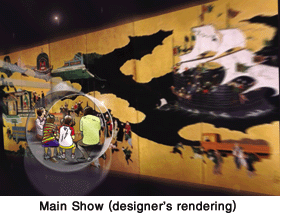 Visitors will then board the cabins of the Ferris wheel to enjoy the main show. As the cabin rises, six scenes that go from the past to the future will unfold before people’s eyes. The story that will be experienced by visitors through the window of their cabins is related to people, vehicles and travel. Famous paintings of the world, including Japan’s Namban Byobu, collages, etc., will create a world filled with surprise and enjoyment; a moving world packed with dreams and mystery.
Visitors will then board the cabins of the Ferris wheel to enjoy the main show. As the cabin rises, six scenes that go from the past to the future will unfold before people’s eyes. The story that will be experienced by visitors through the window of their cabins is related to people, vehicles and travel. Famous paintings of the world, including Japan’s Namban Byobu, collages, etc., will create a world filled with surprise and enjoyment; a moving world packed with dreams and mystery.Once the cabin rises out of the structure into the bright sunshine of the open air, a bird’s-eye-view of the EXPO 2005 venue will spread into view. At its highest point, the cabins will be 50 meters above the ground. The cabins will then go back indoors and leads to the epilogue. Each of the 30 cabins of the Wonder Wheel carries a maximum of four people. The show and circuit takes about eight minutes. No fee is charged to board the Wonder Wheel. |
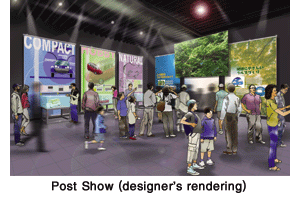 A post show will await those who have disembarked from the Ferris wheel. This is where models of “dream cars” conceived by students studying car design will be on exhibit. Video and panel displays that will convey JAMA’s message regarding safety and the environment will also be shown here.
A post show will await those who have disembarked from the Ferris wheel. This is where models of “dream cars” conceived by students studying car design will be on exhibit. Video and panel displays that will convey JAMA’s message regarding safety and the environment will also be shown here.Look forward to viewing the Expo venue from the sky and the eight-minute travel through time on a Ferris wheel that will enable an experience of vehicles, from the past to the future. |
![]()
![]()
 |
|
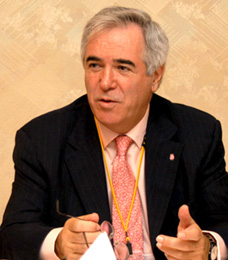 I think that we should take note of the fact that EXPO 2005 Aichi, Japan is going to be held in a country that is very respectful of nature. But nature can also be very harsh in Japan, where there are earthquakes, tsunamis, typhoons, and so on. That is why I think Japanese people love nature but at the same time have a sense of fear of nature. In Japan, there is also the thinking that there are gods and spirits in nature, and it is reflected in the way that rocks, trees, flowers and other elements are treated when making a Japanese garden, or in ikebana flower arrangement or Zen. I think that the original approach in the way Japan deals with nature has developed into art. I think that you can see this too in the way that the EXPO 2005 venue has been designed.
I think that we should take note of the fact that EXPO 2005 Aichi, Japan is going to be held in a country that is very respectful of nature. But nature can also be very harsh in Japan, where there are earthquakes, tsunamis, typhoons, and so on. That is why I think Japanese people love nature but at the same time have a sense of fear of nature. In Japan, there is also the thinking that there are gods and spirits in nature, and it is reflected in the way that rocks, trees, flowers and other elements are treated when making a Japanese garden, or in ikebana flower arrangement or Zen. I think that the original approach in the way Japan deals with nature has developed into art. I think that you can see this too in the way that the EXPO 2005 venue has been designed.It is important for the success of EXPO 2005 that the people of Japan, especially the people of Aichi Prefecture, love this EXPO and are proud of it. This is because that sort of spirit will catch on to the rest of the people and the participating countries as well. There is no such thing as a perfect EXPO, but even if there are a few problems, they can be corrected by the warm support of the local population. EXPO 2005 Aichi, Japan is the first time that Spain will be participating in a world exposition held in Asia. About 75 percent of visitors to an Expo come from the host country. That means that the majority of the recipients of our message will be Japanese people this time. So, we started out by trying to identify what Spain and Japan have in common. The two countries are very far apart; one is the rising sun and the other is the setting sun, so to speak. However, we do have a very long history of exchange that began in the 16th century. It was the Spaniards who were the first to circumnavigate the globe, and they came to the vicinity of Japan on their way. In commemoration of this, a goodwill ship, Nao Victoria, has set sail to Japan for the second time. Nao Victoria is making calls at various ports around the world as it heads towards Japan, carrying with it the message, “Please do come to EXPO 2005 Aichi, Japan.” At the Spanish Pavilion, visitors will be able to get glimpses of the long history of exchange between Spain and Japan, and they should also be able to discover various things that we have in common. Please do come to EXPO 2005, and please do visit the Spanish Pavilion. I am sure it will be one of the most beautiful pavilions. We are also considering holding various events outside of the EXPO venue as well, such as Spain’s famed flamenco and the best gastronomy - the best of Spain will be in Japan during EXPO 2005. |
|
| EXPO 2005 AICHI, JAPAN Newsletter | |
| To read past issues:Back Number | |
| Editor/Publisher: Japan Association for
the 2005 World Exposition Head Office: 1533-1 Ibaragabasama, Nagakute-cho Aichi 480-1101 Japan Nagoya Office: Nagoya Daiya II Bldg 4F, 3-15-1 Meieki Nakamura-ku, Nagoya, Aichi 450-0002 Japan Tokyo Office: Iino Bldg 8F, 2-1-1 Uchisaiwai-cho Chiyoda-ku, Tokyo 100-0011 Japan |
 |
© Japan Association for the 2005 World Exposition
